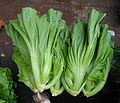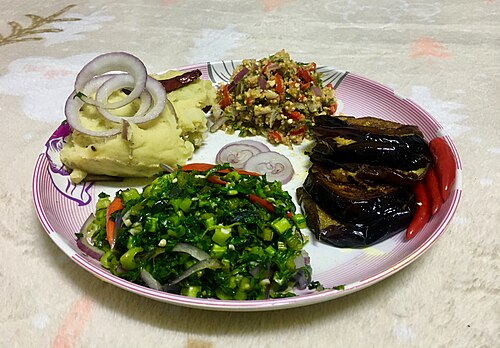Top Qs
Timeline
Chat
Perspective
Brassica juncea
Species of flowering plant From Wikipedia, the free encyclopedia
Remove ads
Brassica juncea, commonly mustard greens, brown mustard, Chinese mustard, Indian mustard, Korean green mustard, leaf mustard, Oriental mustard and vegetable mustard, is a species of mustard plant.[1]
Remove ads
Cultivars
Summarize
Perspective
Brassica juncea cultivars can be divided into four major subgroups: integrifolia, juncea, napiformis, and tsatsai.[2]
Integrifolia
Juncea
Napiformis
Tsatsai
Remove ads
Uses
Summarize
Perspective
Nutrition
In a 100-gram (3+1⁄2-ounce) reference serving, cooked mustard greens provide 110 kilojoules (26 kilocalories) of food energy and are a rich source (20% or more of the Daily Value) of vitamins A, C, and K—K being especially high as a multiple of its Daily Value. Mustard greens are a moderate source of vitamin E and calcium. Greens are 92% water, 4.5% carbohydrates, 2.6% protein and 0.5% fat (table).
Cuisine

The leaves, seeds, and stems of this mustard variety are edible. The plant appears in some form in African, Bangladeshi, Chinese, Filipino, Tripuri, Italian, Indian, Japanese, Okinawan, Nepali, Pakistani, Korean, Southern, Taiwanese, and African-American (soul food) cuisines. Cultivars of B. juncea are grown for their greens, and for the production of mustard oil. The mustard condiment made from the seeds of the B. juncea is called brown mustard and is considered to be spicier than yellow mustard.[7][8]
Because it may contain erucic acid, a potential toxin, mustard oil is restricted from import as a vegetable oil into the United States.[9] Essential oil of mustard, however, is generally recognized as safe by the U.S. Food and Drug Administration.[9] In Russia, this is the main species grown for the production of mustard oil. It is widely used in canning, baking and margarine production in Russia, and the majority of Russian table mustard is also made from B. juncea.
The leaves are used in African cooking,[10] and all plant parts are used in Nepali cuisine, particularly in the mountain regions of Nepal, as well as in the Punjabi cuisine in the northern part of the Indian subcontinent, where a dish called sarson da saag (mustard greens) is prepared.[11] B. juncea subsp. tatsai, which has a particularly thick stem, is used to make the Nepali pickle called achar, and the Chinese pickled products zha cai and ya cai. This plant is called "lai xaak" in Assamese and it is cultivated hugely during the winters. It is eaten in any form in Assam and Northeast, be it boiled or added raw in salad, cooked alone or with pork.
During Taiwanese New Year's Eve, Taiwanese people eat mustard green (Chinese: 長年菜; pinyin: cháng nián cài) as a part of the reunion dinner, symbolizing longevity.[12][13]
The Gorkhas of the Indian states of Darjeeling, West Bengal and Sikkim as well as Nepal prepare pork with mustard greens (also called rayo in Nepali). It is usually eaten with relish and steamed rice, but can also be eaten with roti (griddle breads). In Nepal it is also a common practice to cook these greens with meat of all sorts, especially goat meat; which is normally prepared in a pressure cooker with minimal use of spices to focus on the flavour of the greens and dry chillies. B. juncea (especially the seeds) is more pungent than greens from the closely related B. oleracea (kale, broccoli, and collard greens),[14] and is frequently mixed with these milder greens in a dish of "mixed greens".
Chinese and Japanese cuisines also make use of mustard greens. In Japanese cuisine, it is known as takana and often pickled for use as filling in onigiri or as a condiment. Many varieties of B. juncea cultivars are used, including zha cai, mizuna, takana (var. integrifolia), juk gai choy, and xuelihong. Asian mustard greens are most often stir-fried or pickled. (See pickled mustard.) A Southeast Asian dish called asam gai choy or kiam chai boey is often made with leftovers from a large meal. It involves stewing mustard greens with tamarind, dried chillies and leftover meat on the bone. Brassica juncea is also known as gai choi, siu gai choi, xiao jie cai, baby mustard, Chinese leaf mustard or mostaza.[15]
- Lai shak, mashed potato and fried eggplant
- Fried mustard green dish
- Gat-kimchi, a variety of kimchi made with mustard greens
- Cantonese-style braised mustard greens, with wolfberries
Green manure
Vegetable growers sometimes grow mustard as a green manure. Its main purpose is to act as a mulch, covering the soil to suppress weeds between crops. If grown as a green manure, the mustard plants are cut down at the base when sufficiently grown, and left to wither on the surface, continuing to act as a mulch until the next crop is due for sowing, when the mustard is dug in. In the UK, mustard sown in summer and autumn is cut down starting in October. April sowings can be cut down in June, keeping the ground clear for summer-sown crops.[16] One of the disadvantages of using mustard as a green manure is its propensity to harbor club root.[citation needed]
Phytoremediation
This mustard plant is used in phytoremediation to remove heavy metals, such as lead, from the soil in hazardous waste sites because it has a higher tolerance for these substances and stores the heavy metals in its cells.[17] In particular, Brassica juncea was particularly effective at removing cadmium from soil.[18] The process of removing heavy metals ends when the plant is harvested and properly discarded. Phytoremediation has been shown to be cheaper and easier than traditional methods for heavy metal reduction in soils.[19] In addition, it has the effect of reducing soil erosion, reducing cross-site contamination.[17]
Remove ads
See also
- Sinapis alba (formerly Brassica alba) – yellow or white mustard, another mustard variety
- Brassica oleracea – wild cabbage
- Brassica nigra – black mustard, another mustard variety
- Brassica rapa – related family of edible greens used in Asian cooking
- Brassica carinata – Ethiopian mustard
- For other edible plants in the family Brassicaceae, see cruciferous vegetables.
References
Further reading
External links
Wikiwand - on
Seamless Wikipedia browsing. On steroids.
Remove ads














